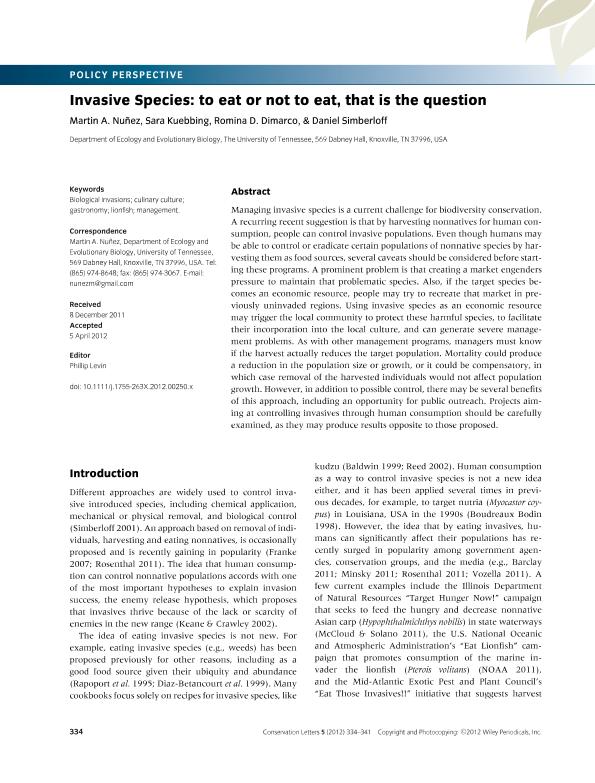Mostrar el registro sencillo del ítem
dc.contributor.author
Nuñez, Martin Andres

dc.contributor.author
Kuebbing, Sara
dc.contributor.author
Dimarco, Romina Daniela

dc.contributor.author
Simberloff, Daniel
dc.date.available
2023-05-22T14:32:38Z
dc.date.issued
2012-10
dc.identifier.citation
Nuñez, Martin Andres; Kuebbing, Sara; Dimarco, Romina Daniela; Simberloff, Daniel; Invasive Species: To eat or not to eat, that is the question; Wiley Blackwell Publishing, Inc; Conservation Letters; 5; 5; 10-2012; 334-341
dc.identifier.issn
1755-263X
dc.identifier.uri
http://hdl.handle.net/11336/198362
dc.description.abstract
Managing invasive species is a current challenge for biodiversity conservation. A recurring recent suggestion is that by harvesting nonnatives for human consumption, people can control invasive populations. Even though humans may be able to control or eradicate certain populations of nonnative species by harvesting them as food sources, several caveats should be considered before starting these programs. A prominent problem is that creating a market engenders pressure to maintain that problematic species. Also, if the target species becomes an economic resource, people may try to recreate that market in previously uninvaded regions. Using invasive species as an economic resource may trigger the local community to protect these harmful species, to facilitate their incorporation into the local culture, and can generate severe management problems. As with other management programs, managers must know if the harvest actually reduces the target population. Mortality could produce a reduction in the population size or growth, or it could be compensatory, in which case removal of the harvested individuals would not affect population growth. However, in addition to possible control, there may be several benefits of this approach, including an opportunity for public outreach. Projects aiming at controlling invasives through human consumption should be carefully examined, as they may produce results opposite to those proposed.
dc.format
application/pdf
dc.language.iso
eng
dc.publisher
Wiley Blackwell Publishing, Inc

dc.rights
info:eu-repo/semantics/openAccess
dc.rights.uri
https://creativecommons.org/licenses/by-nc-sa/2.5/ar/
dc.subject
BIOLOGICAL INVASIONS
dc.subject
CULINARY CULTURE
dc.subject
GASTRONOMY
dc.subject
LIONFISH
dc.subject
MANAGEMENT
dc.subject.classification
Conservación de la Biodiversidad

dc.subject.classification
Ciencias Biológicas

dc.subject.classification
CIENCIAS NATURALES Y EXACTAS

dc.title
Invasive Species: To eat or not to eat, that is the question
dc.type
info:eu-repo/semantics/article
dc.type
info:ar-repo/semantics/artículo
dc.type
info:eu-repo/semantics/publishedVersion
dc.date.updated
2023-05-15T14:06:23Z
dc.journal.volume
5
dc.journal.number
5
dc.journal.pagination
334-341
dc.journal.pais
Estados Unidos

dc.description.fil
Fil: Nuñez, Martin Andres. University of Tennessee; Estados Unidos. Consejo Nacional de Investigaciones Científicas y Técnicas. Centro Científico Tecnológico Conicet - Patagonia Norte. Instituto de Investigaciones en Biodiversidad y Medioambiente. Universidad Nacional del Comahue. Centro Regional Universidad Bariloche. Instituto de Investigaciones en Biodiversidad y Medioambiente; Argentina
dc.description.fil
Fil: Kuebbing, Sara. University of Tennessee; Estados Unidos
dc.description.fil
Fil: Dimarco, Romina Daniela. University of Tennessee; Estados Unidos. Consejo Nacional de Investigaciones Científicas y Técnicas; Argentina
dc.description.fil
Fil: Simberloff, Daniel. University of Tennessee; Estados Unidos
dc.journal.title
Conservation Letters
dc.relation.alternativeid
info:eu-repo/semantics/altIdentifier/url/http://onlinelibrary.wiley.com/doi/10.1111/j.1755-263X.2012.00250.x/abstract
dc.relation.alternativeid
info:eu-repo/semantics/altIdentifier/doi/http://dx.doi.org/10.1111/j.1755-263X.2012.00250.x
Archivos asociados
